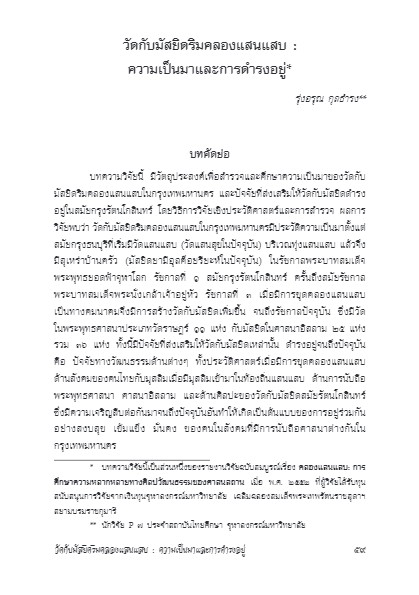รุ่งอรุณ กุลธำรง
บทคัดย่อ
บทความวิจัยนี้ มีวัตถุประสงค์เพื่อสำรวจและศึกษาความเป็นมาของวัดกับมัสยิดริมคลองแสนแสบในกรุงเทพมหานคร และปัจจัยที่ส่งเสริมให้วัดกับมัสยิดดำรงอยู่ในสมัยกรุงรัตนโกสินทร์ โดยวิธีการวิจัยเชิงประวัติศาสตร์และการสำรวจ ผลการวิจัยพบว่า วัดกับมัสยิดริมคลองแสนแสบในกรุงเทพมหานครมีประวัติความเป็นมาตั้งแต่สมัยกรุงธนบุรีที่เริ่มมีวัดแสนแสบ (วัดแสนสุขในปัจจุบัน) บริเวณทุ่งแสนแสบ แล้วจึง
มีสุเหร่าบ้านครัว (มัสยิดยามีอุลค็อยรียะห์ในปัจจุบัน) ในรัชกาลพระบาทสมเด็จพระพุทธยอดฟ้าจุฬาโลก รัชกาลที่ 1 สมัยกรุงรัตนโกสินทร์ ครั้นถึงสมัยรัชกาลพระบาทสมเด็จพระนั่งเกล้าเจ้าอยู่หัว รัชกาลที่ 3 เมื่อมีการขุดคลองแสนแสบเป็นทางคมนาคมจึงมีการสร้างวัดกับมัสยิดเพิ่มขึ้น จนถึงรัชกาลปัจจุบัน ซึ่งมีวัดในพระพุทธศาสนาประเภทวัดราษฎร์ 11 แห่ง กับมัสยิดในศาสนาอิสลาม 25 แห่ง รวม 36 แห่ง ทั้งนี้มีปัจจัยที่ส่งเสริมให้วัดกับมัสยิดเหล่านั้นดำรงอยู่จนถึงปัจจุบัน คือ ปัจจัยทางวัฒนธรรมด้านต่างๆ ทั้งประวัติศาสตร์เมื่อมีการขุดคลองแสนแสบ ด้านสังคมของคนไทยกับมุสลิมเมื่อมีมุสลิมเข้ามาในท้องถิ่นแสนแสบ ด้านการนับถือพระพุทธศาสนา ศาสนาอิสลาม และด้านศิลปะของวัดกับมัสยิดสมัยรัตนโกสินทร์ ซึ่งมีความเจริญสืบต่อกันมาจนถึงปัจจุบันอันทำให้เกิดเป็นต้นแบบของการอยู่ร่วมกันอย่างสงบสุข เข้มแข็ง มั่นคง ของคนในสังคมที่มีการนับถือศาสนาต่างกันในกรุงเทพมหานคร
(ตีพิมพ์ใน วารสารไทยศึกษา ปีที่ 8 ฉบับที่ 2 (สิงหาคม 2555 – มกราคม 2556) หน้า 59-96)
Buddhist Monasteries and Muslim Mosques Beyond Saensaeb Canal : Emergence and Existence
Rungaroon Kulthamrong
Abstract
This research article aims to explore and study the history of the emergence of Buddhist monasteries and Muslim mosques established along Saensaeb Canal in Bangkok. As well, the contributing factors in the continuation of the co-existence of these religious sacred places for worship and ceremony during the Rattanakosin period has been explored using historical research methodology and a physical survey. The research finds that the history of the emergence of monasteries and mosques began in the Thonburi period with the establishment of Saensaeb Temple (or Saen Suk Temple) in the area of the Saensaeb rice f ield, and then the Bankrua Mosque was erected (or Jamiulkhoyriyah Musjid) during the reign of King Rama I of the Rattanakosin period. From the reign of King Rama III onwards, after digging the Saensaeb Canal as a channel for transportation, many monasteries and mosques have been constructed until the present reign. There are a total of 36 religious places along the canal, 11 are community Buddhist monasteries and 25 are Muslim mosques.
A number of factors have contributed to the emergence and continuation of peaceful relations between those monasteries and mosques, such as historical and socio-cultural factors that have existed since the construction of Saensaeb Canal; social harmony between Thai and Muslim people in the community; religious commitment of residents; and the relationship of artistic interest and spiritual direction between monasteries and mosques in the Rattanakosin period. An environment that fosters social relationships of both religious and cultural groups is ref lected in the model of peaceful and harmonious interaction between people of different religious and spiritual beliefs in this Bangkok community.
(Published in Journal of Thai Studies Volume 8 Number 2 (August 2012 – January 2013) Page 59-96)
บทความ / Full Text : Download
